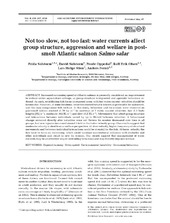| dc.contributor.author | Solstorm, Frida | |
| dc.contributor.author | Solstorm, David | |
| dc.contributor.author | Oppedal, Frode | |
| dc.contributor.author | Olsen, Rolf Erik | |
| dc.contributor.author | Stien, Lars Helge | |
| dc.contributor.author | Fernö, Anders | |
| dc.date.accessioned | 2017-06-29T13:03:11Z | |
| dc.date.available | 2017-06-29T13:03:11Z | |
| dc.date.issued | 2016 | |
| dc.identifier.issn | 1869-215X | en_US |
| dc.identifier.uri | https://hdl.handle.net/1956/16128 | |
| dc.description.abstract | Increased swimming speed of Atlantic salmon is generally considered an improvement to welfare under aquaculture settings, as group structure is improved and agonistic behaviour reduced. As such, establishing fish farms in exposed areas with fast water current velocities should be favourable. However, at some locations, velocities exceed what is known as preferable for salmonids, and this may compromise fish welfare. In this study, behaviour and fin erosion were observed on post-smolt salmon stocked at 39 kg m-3 in raceways at 3 water current velocities: fast (1.5 body lengths [BL] s-1), moderate (0.8 BL s-1) and slow (0.2 BL s-1). Movements that affect group structure and interactions between individuals varied by up to 20-fold between velocities. A behavioural change occurred directly after velocities were set. Severe fin erosion decreased over time in all groups, but new injuries increased almost 3-fold in the faster-velocity group. Our results suggest that moderate velocity is ideal from a welfare perspective. At slow velocity, higher frequency of structural movements and between-individual interactions could be stressful for the fish. At faster velocity, the fish have to focus on swimming, which could increase unintentional collisions with obstacles and other individuals and result in new fin erosion. Our results suggest that management of water currents may be an effective way of controlling behaviour and may thereby improve welfare. | en_US |
| dc.language.iso | eng | eng |
| dc.publisher | Inter-Research | en_US |
| dc.relation.ispartof | <a href="http://hdl.handle.net/1956/16129" target="_blank">The effect of water currents on post-smolt Atlantic salmon, Salmo salar (L.). A welfare approach to exposed aquaculture</a> | en_US |
| dc.rights | Attribution CC BY | eng |
| dc.rights.uri | http://creativecommons.org/licenses/by/4.0 | eng |
| dc.subject | Exposed farming | eng |
| dc.subject | Swim speed | eng |
| dc.subject | Environmental variability | eng |
| dc.subject | Swimming behaviour | eng |
| dc.title | Not too slow, not too fast: water currents affect group structure, aggression and welfare in post-smolt Atlantic salmon Salmo salar | en_US |
| dc.type | Peer reviewed | |
| dc.type | Journal article | |
| dc.description.version | publishedVersion | en_US |
| dc.rights.holder | Copyright 2016 The Author(s) | en_US |
| dc.identifier.doi | https://doi.org/10.3354/aei00178 | |
| dc.identifier.cristin | 1436663 | |
| dc.source.journal | Aquaculture Environment Interactions | |
| dc.source.40 | 8 | |
| dc.source.pagenumber | 339-347 | |

